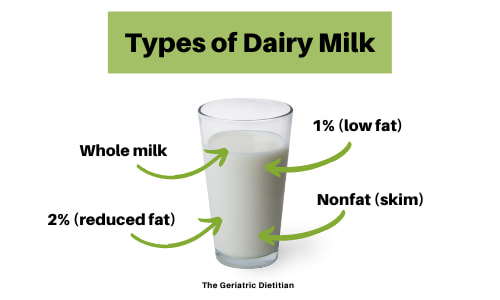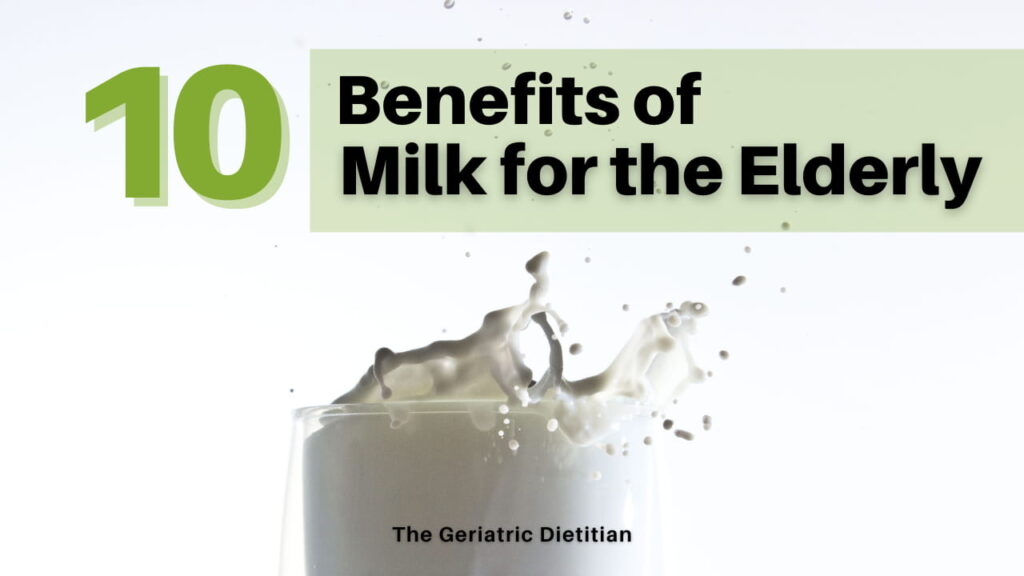“Benefits of Milk for the Elderly” was written by Mitzi de Maa. Edited/reviewed by Katie Dodd, MS, RDN, CSG, LD, FAND. Mitzi is a dietetic intern based out of Florida.
Did you know that consuming dairy milk has wonderful health benefits for older adults? In this article, we will discuss 10 nutritional benefits of milk for the elderly.
Types of Milk
There are different types of milk. Each type has different characteristics and nutritional content that we will learn in this article.
The main difference among dairy milks is the fat content in each serving. Whole milk has the most fat, while nonfat has the least.

Dairy Milk vs Plant Beverages
Nowadays there are plenty of non-dairy options for people who have allergies, lactose intolerances, or personal preference for beverages that are non-dairy.
Plant beverages include:
- Soy
- Quinoa
- Rice
- Oat
- Sesame
- Almond
- Coconut
- Hemp
- Hazelnut
- Cashew
- Flax
In comparison to dairy milk, the nutritional facts of plant-based beverages vary extensively. Therefore, it is important to check the food label of each plant beverage individually.

10 Benefits of Milk for the Elderly
Without further ado, let’s learn about 10 benefits of milk for the elderly:
- Calories
- Protein
- Fat
- Calcium
- Vitamin D
- Potassium
- Vitamin A
- Riboflavin
- Magnesium
- Phosphorus
1. Calories
The first benefit of consuming milk as an older adult is that milk provides a great number of calories in one cup. This can help prevent unintended weight loss and it helps older adults maintain a healthy weight.
Unintended or involuntary weight loss is a common struggle that many older adults go through. Appetite decreases as people age, their ability to cook meals is not the same, and overall, they can have difficulty eating the same number of calories as before.
The following table shows the number of calories in the four types of dairy milk. Flavored milks like chocolate or strawberry typically have more calories from the added syrups.
| Milk Type | Serving Size | Kcal |
| Whole Milk | 1 cup | 150 kcal |
| 2% or reduced fat | 1 cup | 122 kcal |
| 1% or lowfat | 1 cup | 106 kcal |
| Nonfat or skim | 1 cup | 83 kcal |
2. Protein
Milk is a great source of protein. Protein is an important nutrient for aging adults as it helps to protect against muscle loss.
Sarcopenia is a syndrome that gradually occurs with age. It causes loss of muscle mass, strength, and function in older adults (1).
Why is sarcopenia related to protein? Because protein is a key nutrient for muscle health in older adults. And consuming adequate amounts along with resistance exercise can prevent sarcopenia.
Slowing or preventing sarcopenia can mean more independence, fewer falls, fewer trips to the hospital, and improved quality of life in the elderly.
Daily Nutritional Goals for Protein
Below are the daily nutritional goals for protein measured in grams.
| Age 19-59 | Age 60 and older | |
| Men | 56 grams | 56 grams |
| Women | 46 grams | 46 grams |
Referenced from Table A1-2 of the Dietary Guidelines for Americans, 2020-2025 (2).
Drinking 1 cup of milk per day of either whole, 2%, 1%, or nonfat dairy milk, provides 8 grams of protein in your day.
Therefore, milk is an easy way to get close to the recommended daily amount of protein for an adult 60 and older.

3. Fat
Fat is a nutrient that is essential for maintaining good health, especially as we age.
Some of the benefits of fats are:
- Helping absorb nutrients such as Vitamin A, D, E, and K (3)
- Giving the body energy
- Protecting vital organs
Milk is a great source of fat for those seeking to add more of it into their daily diets.
1 cup of whole milk contains 8 grams of fat, 1 cup of 2% milk provides 5g of fat, 1 cup of 1% milk has 2g of fat, and 1 cup of nonfat milk has 0 grams of fat.
If you want to get the most fat per 1 cup of milk, choose whole milk.

4. Calcium
Calcium is the most essential mineral for bone health. Adequate amounts are needed throughout our lives.
Adequately consuming calcium has shown to reduce the following in certain populations (4):
- Reduce the risk of fractures
- Osteoporosis
- Diabetes
Calcium deficiencies can happen to older adults due to low intake of calcium over time, osteoporosis, or because of medication since some of them can decrease dietary calcium absorption (4).
The good news is that drinking milk can reduce the likelihood of becoming deficient in calcium.
The following graphic shows the number of milligrams in 1 cup of the following milk types:

Calcium tip:
Calcium is absorbed best if you eat foods rich in calcium throughout the day rather than in just one meal (5).
Daily Nutritional Goals for Calcium
Below are the daily nutritional goals for calcium measured in milligrams.
| Age 19-50 | Age 51+ | |
| Men | 1,000 mg | 1,000 mg |
| Women | 1,000 mg | 1,200 mg |
5. Vitamin D
Vitamin D is an important nutrient and hormone that keeps bones strong.
Additionally, vitamin D helps the body absorb and retain calcium and phosphorus. Both of these are important for building bones, maintaining and improving muscle and physical strength (6).
Vitamin D deficiency is quite common because this vitamin can only be obtained from a small number of foods in the diet, sunlight or supplements.
One of the benefits of milk for the elderly is that most milk is fortified. This means that vitamin D has been added to it, making it a good source of dietary Vitamin D for the elderly.
In certain instances, vitamin D supplementation might be needed but that should be discussed with your healthcare provider.
The following graphic shows the number of IU (International Units) in 1 cup of the following milk types:

Daily Nutritional Goals of Vitamin D
Below are the daily nutritional goals of Vitamin D measured in IU’s (International Units).
| Age 19-70 | Age 71+ | |
| Men | 600 IU | 800 IU |
| Women | 600 IU | 800 IU |
Referenced from Table A1-2 of the Dietary Guidelines for Americans, 2020-2025 (2).
6. Potassium
Milk is an excellent source of potassium. It provides between 150-411 mg in 1 cup of dairy milk depending on the type of milk.
Eating adequate amounts of potassium is associated with a decreased risk of strokes, hypertension, osteoporosis, and kidney stones which are conditions that can affect the elderly.
The following graphic shows the amount of potassium in 1 cup of the following milk types:

Daily Nutritional Goals for Potassium
Below are the daily nutritional goals for Potassium measured in mg.
| Age 19-50 | 51+ | |
| Men | 3400 mg | 3400 mg |
| Women | 2600 mg | 2300 mg |
If you have a condition that limits potassium consumption, it is important to follow your healthcare provider’s recommendations.
7. Vitamin A
Vitamin A is found in many foods including milk.
Vitamin A has many functions and benefits in the body such as (7):
- Helping the eyes adjust to light changes
- Regulating the immune system
- Moistening the mouth, nose, throat, and lungs
- Playing a role in the prevention of certain cancers
Dairy products are one of the major sources where Americans get their vitamin A from.
The following graphic shows the number of vitamin A in 1 cup of the following milk types:

Daily Nutritional Goals for Vitamin A
Below are the daily nutritional goals for Vitamin A measured in mcg (micrograms).
| Age 19-50 | 51+ | |
| Men | 900 mcg | 900 mcg |
| Women | 700 mcg | 700 mcg |
8. Riboflavin
Did you know that riboflavin is a vitamin that helps you turn the food you eat into energy for your body? (8).
It also works as an antioxidant and when consumed adequately, it can even reduce the risk of developing age-related cataracts for the elderly (9).
Riboflavin can be found in different types of foods but milk and dairy products are good sources of it.
The following graphic shows the amount of riboflavin in 1 cup of the following milk types:

Daily Nutritional Goals for Riboflavin
Below are the daily nutritional goals for Riboflavin measured in mg (milligrams).
| Age 19-50 | 51+ | |
| Men | 1.3 mg | 1.3 mg |
| Women | 1.1 mg | 1.1 mg |
9. Magnesium
Magnesium is a mineral that plays an important role in our bodies like helping our heart, muscles, nerves, and bones function well.
Eating adequate amounts of magnesium is especially important for older adults because they are less likely to eat enough magnesium-rich foods compared to younger people (9).
The following graphic shows the amount of magnesium in 1 cup of the following milk types:

Daily Nutritional Goals for Magnesium
Below are the daily nutritional goals for Magnesium measured in mg (milligrams).
| Age 19-50 | 51+ | |
| Men | 400 mg | 420 mg |
| Women | 320 mg | 320 mg |
10. Phosphorus
The main role of phosphorus in our bodies is in:
- Building strong bones and teeth
- Helping our body use important nutrients such as carbohydrates, fats, and proteins so it can turn them into energy
Milk is a good source of phosphorus. It provides the following number of milligrams in 1 cup of the following milk types:

Daily Nutritional Goals for Phosphorus
Below are the daily nutritional goals for Phosphorus measured in mg (milligrams).
| Age 19-50 | 51+ | |
| Men | 700 mg | 700 mg |
| Women | 700 mg | 700 mg |
Conclusion
The elderly population needs key nutrients in order to thrive and enjoy good health.
Milk is a nutritious beverage that can contribute to the health of elderly people by:
- Preventing unintended weight loss and helping maintain a healthy weight
- Providing essential vitamins and minerals
- Being a good source of carbohydrate, protein, and fat
We hope this article hoped to better outline the 10 benefits of milk in the elderly. Best of luck!

(Feel free to use this infographic; please link back to this post and give credit to The Geriatric Dietitian)
References
- Baum JI, Kim IY, Wolfe RR. Protein Consumption and the Elderly: What Is the Optimal Level of Intake?. Nutrients. 2016;8(6):359. Published 2016 Jun 8. doi:10.3390/nu8060359
- Dietary Guidelines Dietary Guidelines for Americans, 2020-2025 . Dietary Guidelines for Americans, 2020-2025 and Online Materials | Dietary Guidelines for Americans. https://www.dietaryguidelines.gov/resources/2020-2025-dietary-guidelines-online-materials. Accessed March 30th, 2022.
- National Research Council (US) Committee on Diet and Health. Diet and Health: Implications for Reducing Chronic Disease Risk. Washington (DC): National Academies Press (US); 1989. 11, Fat-Soluble Vitamins. Available from: https://www.ncbi.nlm.nih.gov/books/NBK218749/
- Beto JA. The role of calcium in human aging. Clin Nutr Res. 2015;4(1):1-8. doi:10.7762/cnr.2015.4.1.1
- Ellis CE. Calcium. EatRight. https://www.eatright.org/food/vitamins-and-supplements/types-of-vitamins-and-nutrients/calcium. Accessed April 1, 2022.
- Remelli F, Vitali A, Zurlo A, Volpato S. Vitamin D Deficiency and Sarcopenia in Older Persons. Nutrients. 2019;11(12):2861. Published 2019 Nov 21. doi:10.3390/nu11122861
- Fat-soluble vitamins: A, D, E, and K – 9.315 – extension. https://extension.colostate.edu/topic-areas/nutrition-food-safety-health/fat-soluble-vitamins-a-d-e-and-k-9-315/. Accessed April 1, 2022.
- FCS8668/FY211: Facts about riboflavin. https://edis.ifas.ufl.edu/publication/FY211. Accessed April 1, 2022.
- Older adults. Linus Pauling Institute. https://lpi.oregonstate.edu/mic/life-stages/older-adults. Published January 4, 2022. Accessed April 1, 2022.
